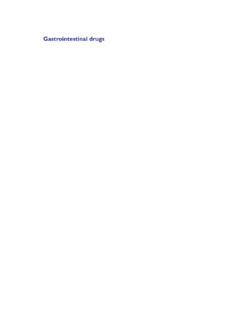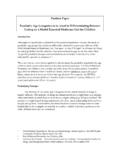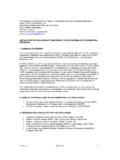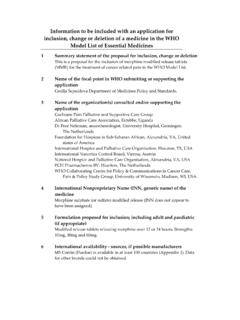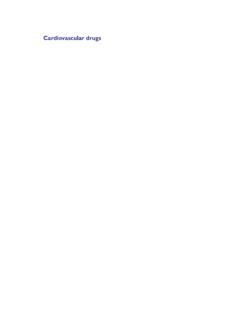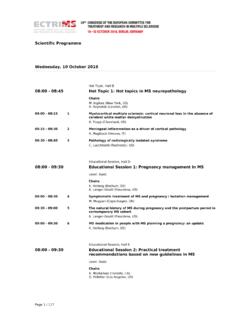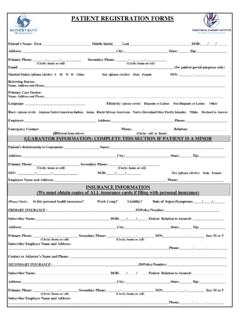Transcription of EXTERNAL REVIEW – THEOPHYLLINE - WHO archives
1 REVIEW THEOPHYLLINE Background The current 13th edition of the WHO Model Essential Medicines List (dated April 2003) includes THEOPHYLLINE as an Essential medicine . The listing is as shown below (together with the other respiratory tract medicines listed). Box 1: 13th Model EML listing of medicines acting on the respiratory tract No indication is given as to whether the tablet formulations listed are immediate-release or of a sustained release form. The entry in the WHO Model Formulary is more extensive, as shown in the box on the next page. It is made clear that the 100mg tablets listed are of the immediate release type, whereas the 200mg and 300mg variants are of a sustained release type. Two important safety messages relevant to the use of methylxanthines are made: Plasma THEOPHYLLINE concentration for optimum response 10 20 mg/litre (55 110 micromol/litre); narrow margin between therapeutic and toxic dose; see notes above; a range of 5 15 mg/litre ( micromol/litre) may be effective and associated with fewer adverse effects , and Patients taking oral THEOPHYLLINE (or aminophylline) should not normally receive intravenous aminophylline unless plasma- THEOPHYLLINE concentration is available to guide dosage.
2 THEOPHYLLINE and AminophyllineAminophylline is a representative xanthine bronchodilator. Various drugs including THEOPHYLLINE can serve as alternatives Tablets , THEOPHYLLINE 100 mg Modified-release tablets , THEOPHYLLINE 200 mg, 300 mg Injection (Solution for injection), aminophylline 25 mg/ml, 10-ml ampoule Uses: chronic asthma including nocturnal asthma; acute severe asthma Contraindications: porphyria; known hypersensitivity to ethylenediamine (for aminophylline) Precautions: cardiac disease, hypertension, hyperthyroidism, peptic ulcer, epilepsy, hepatic impairment (Appendix 5), pregnancy (Appendix 2), breastfeeding (Appendix 3), elderly, fever; smokers may require larger or more frequent doses; interactions: Appendix 1 Dosage: Chronic asthma, by mouth (as tablets), ADULT and CHILD over 12 years, 100 200 mg 3 4 times daily after food; by mouth (as modified-release tablets) ADULT 300 450 mg every 12 hours Nocturnal asthma, by mouth (as modified-release tablets), ADULT total daily requirement as single evening dose Note.
3 Plasma THEOPHYLLINE concentration for optimum response 10 20 mg/litre (55 110 micromol/litre); narrow margin between therapeutic and toxic dose; see notes above; a range of 5 15 mg/litre ( micromol/litre) may be effective and associated with fewer adverse effects Acute severe asthma (not previously treated with THEOPHYLLINE ), by slow intravenous injection (over at least 20 minutes), ADULT and CHILD 5 mg/kg; maintenance, by intravenous infusion , ADULT 500 micrograms/kg/hour; CHILD 6 months 9 years, 1 mg/kg/hour, 10 16 years, 800 micrograms/kg/hour, adjusted according to plasma- THEOPHYLLINE concentration Note. Patients taking oral THEOPHYLLINE (or aminophylline) should not normally receive intravenous aminophylline unless plasma- THEOPHYLLINE concentration is available to guide dosage Adverse effects: nausea and other gastrointestinal disturbances, restlessness, anxiety, tremor, palpitations, headache, insomnia, dizziness; convulsions, arrhythmias and hypotension especially if given by rapid injection; urticaria, erythema and exfoliative dermatitis resulting from hypersensitivity to ethylenediamine component of aminophylline.
4 Box 2. WHO Model Formulary 2004 entry for THEOPHYLLINE and aminophylline 2 This REVIEW therefore considers the evidence for the possible deletion of THEOPHYLLINE as a specific oral methylxanthine in relation to the listed indications ( chronic asthma including nocturnal asthma; acute severe asthma ), as well as in the management of chronic obstructive pulmonary disease (COPD). Submissions An application has been lodged by the WHO Chronic Respiratory Disease and Arthritis (CRA) division of the Department of Management of Noncommunicable Diseases. Citing the support of GINA (Global Initiative for Asthma), GOLD (Global Initiative for Chronic Obstructive Lung Disease), JSA (Japanese Society of Allergology) and JSPA (Japanese Society of Pediatric Allergy), the DRA submission argues as follows: THEOPHYLLINE is proposed to be retained in the WHO Model list of essential medicines for Action on the respiratory tract antiasthmatic and medicines for chronic obstructive pulmonary disease.
5 Following summary of reports on THEOPHYLLINE shows THEOPHYLLINE is an effective drug with bronchodilating and anti-inflammatory effects and can be used alone or in combination in asthma and COPD. Its safety has been verified. THEOPHYLLINE is the only oral agent among the essential drugs in asthma and COPD. Current international and national guidelines for asthma and COPD have recommended sustained release THEOPHYLLINE for long-term control of these diseases. Further, the CRA submission makes it clear that the submission calls for the retention of THEOPHYLLINE as an individual medicine (as listed in the EML). However, it does not include COPD as a listed indication in the suggested Model Formulary text. Nonetheless, this REVIEW will include consideration of that possibility. A second submission was made on behalf of the International Society of Drug Bulletins.
6 This REVIEW concluded as follows: THEOPHYLLINE has modest effects in asthma and its unwanted effects are troublesome, however it should remain on the WHO Model List of Essential Medicines, to be used as a second-line drug for the treatment of asthma in patients who do not respond to a beta 2 agonist plus an inhaled corticosteroid, and, where appropriate, an anticholinergic drug. The importance of therapeutic monitoring should be stressed, but even so, the product should continue to be available even where routine measurement of plasma concentration cannot be provided. 3 EXTERNAL REVIEW Current positioning of the agent in international guidelines 1. Asthma - adults The most widely quoted asthma guideline is that provided by the Global Initiative for Asthma (GINA), which was updated in THEOPHYLLINE is included as an option, but not first-line choice in mild, moderate and severe persistent asthma.
7 The operative statements are as follows: For intermittent asthma, no daily medication is recommended for the vast majority of patients. Treatment of exacerbations should depend on the severity of the exacerbation. A rapid-acting inhaled 2-agonist may be taken as needed to relieve asthma symptoms. The occasional patient with intermittent asthma, but severe exacerbations, should be treated as having moderate persistent asthma. Patients with mild persistent asthma require controller medication every day to achieve and maintain control of their asthma. Treatment with an inhaled glucocorticosteroid is preferred. Sustained-release THEOPHYLLINE , cromones, or a leukotriene modifier are other options. The preferred therapy for moderate persistent asthma is regular treatment with a combination of inhaled glucocorticosteroid and a long-acting inhaled 2-agonist twice daily.
8 Sustained-release THEOPHYLLINE or a leukotriene modifier are alternatives to the 2-agonist in this combination therapy. An alternative to combination therapy is a higher dose of inhaled glucocorticosteroid. The primary therapy for severe persistent asthma includes inhaled glucocorticosteroid at higher doses plus a long-acting inhaled 2-agonist twice daily. Alternatives to the long-acting inhaled 2-agonist for add-on treatment are an oral sustained-release THEOPHYLLINE , leukotriene modifier, or oral 2-agonist. These drugs may also be added to the combination of high-dose inhaled glucocorticosteroid and long-acting inhaled 2-agonist if necessary. It is also very clear from these statements that immediate release THEOPHYLLINE is not a preferred option, nor is oral THEOPHYLLINE in any form an alternative to inhaled rapid-acting inhaled 2-agonists in patients with intermittent asthma.
9 The level of uncertainty about the mechanism of action of the methylxanthines and their place in therapy is also well described in the GINA Workshop Report, as updated. These are quoted verbatim, as they encapsulate all the issues of contention:a The first section deals with their use as controllers , the next as relievers . Methylxanthines. Mode of administration Oral (ingested). Mechanisms of action THEOPHYLLINE is a bronchodilators that may have extrapulmonary effects, including anti-inflammatory effects. The a NOTE: References numbers from the original have been removed. Evidence ratings range from A (Rich body of evidence) to D (Panel consensus judgment). 4bronchodilator effect of THEOPHYLLINE may be related to phosphodiesterase inhibition and is seen at high concentrations (>10 mg/l), whereas the anti-inflammatory effect is due to an unknown mechanism and may occur at lower concentrations (5-10 mg/l).
10 At low doses THEOPHYLLINE has some minor influence on chronic airway inflammation in asthma. Most studies show little or no effect on airway hyperresponsiveness. Role in therapy Sustained-release THEOPHYLLINE and aminophylline can be used as controller medications in asthma. Many clinical studies have shown that long-term treatment with sustained-release THEOPHYLLINE is effective in controlling asthma symptoms and improving lung function. When given as a sustained-release preparation, it has a long duration of action and is thus useful in the control of nocturnal symptoms that persist despite the regular treatment with anti-inflammatory therapy. THEOPHYLLINE is also useful as an additional bronchodilator in patients with severe asthma. Now that THEOPHYLLINE at low doses has been shown to be effective in asthma control in both adults and children, it may be used in patients with milder disease and as an add-on therapy to low or high doses of inhaled glucocorticosteroids when further asthma control is needed (Evidence B).

